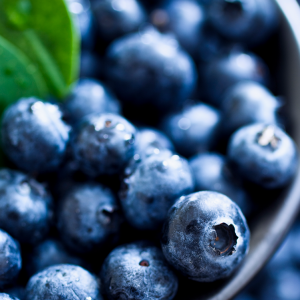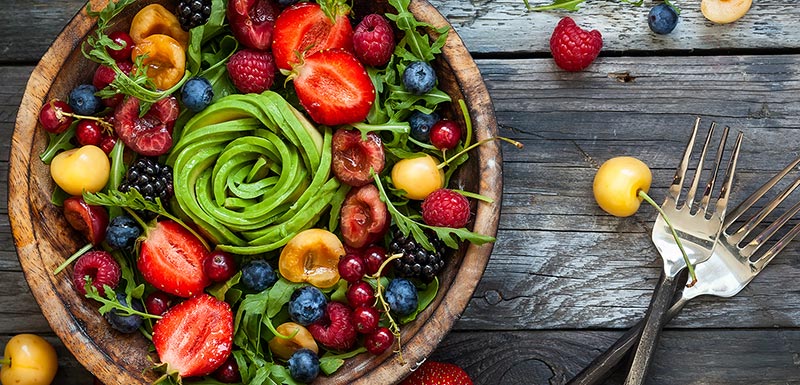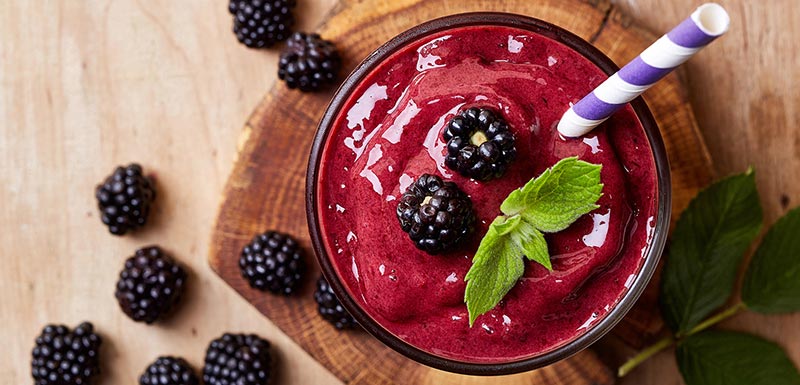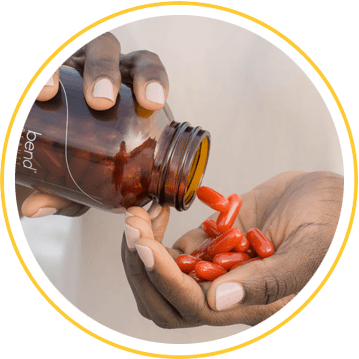
Did you know that plants produce color partly in order to protect themselves from harmful ultraviolet (UV) sun radiation? Well, those same intense and beautiful hues, found in many foods, can also protect you!
One group of such pigments includes 600 types of naturally occurring anthocyanins. These water-soluble, deep blue and purple colored substances absorb blue-green light and UV rays (Rojo 2013). They are found in many foods including blueberries, blackberries, raspberries, strawberries, cherries, purple grapes, beets, red cabbage, and red beans. The current intake of anthocyanins in the United States (US) is about 200 mg daily (Wang 2008).

Hundreds of scientific studies show that anthocyanins have anti-oxidant, anti-inflammatory, and anti-cancer properties (Wang 2008) making them useful to protect health in general, but particularly suited to protecting skin from sun damage that contributes to skin aging and cancer (Rojo 2013). Even so, there are currently no dietary intake recommendations (Cerletti 2017). However, the significance of anthocyanins to health has been so well recognized that two studies spanning 10 years were funded by the European Union (EU) [i.e. the FLORA (FLavonoids and related phenolics for healthy living using ORally recommended Antioxidants) and ATHENA (AnTHocyanin and polyphenol bioactives for Health Enhancement through Nutritional Advancement)] (Cerletti 2017). These studies and others, have confirmed that anthocyanins provide natural sun protection through the following means:
Improved Anti-oxidant Capacity
The most important accelerator of skin aging is UV radiation exposure. A single exposure to intense radiation triggers various inflammatory pathways and oxidative damage, while repeated exposure leads to accelerated skin aging (photo-aging), thickened skin, and precancerous lesions. In addition, repeated exposure causes excessive formation of typically necessary enzymes called metalloproteinases (MMP), which when present at abnormally elevated levels, degrade skin collagen and elastin, leading to wrinkles (Rojo 2013).
Anthocyanins reduce MMP production (Wang 2008). They also protect against UV skin damage by inactivating highly reactive molecules such as free radicals and reactive oxygen species (ROS) formed during sun exposure that start a chain reaction producing significant cell and tissue damage. As well, they increase levels of Phase II detoxification enzymes (anti-oxidant proteins) including glutathione S-transferase, that help eliminate toxins, and reduce lipid peroxidation (fat damage) and DNA damage that can trigger cancer formation (Wang 2008). Bend Beauty Renew + Protect is Health-Canada authorized to provide a dose of antioxidants for skin health. Click here to shop now.
Reduced Inflammation
Chronic inflammation affects many people and is a concern because it can activate processes that initiate cancer. Higher internal production of two inflammatory biomarker proteins, nuclear factor-kappa (NF-KB) and cyclooxygenase-2 (COX-2) commonly accompanies many cancers (Wang 2008). Factors contributing to inflammation include low anti-oxidant status, nutrient deficiencies, increased toxin load and free radical damage.
Higher dietary anthocyanin intake is associated with lower inflammatory biomarkers indicating oxidative stress according to a population study including 2375 US adults (Cassidy 2015). In addition preclinical studies found anthocyanins reduce NF-KB and COX-2 levels (Wang 2008). These results suggest the anti-inflammatory effects of anthocyanins are key to their health protective and anti-cancer effects, respectively.
Enhanced Metabolism
Cancer is a metabolic disease that thrives when glucose metabolism is compromised such that people with diabetes are more likely to develop many forms of cancer (Giovannucci 2010). Anthocyanins may reduce this risk partly through glucose metabolism effects. In fact, people who eat the most anthocyanins are 15% less likely to develop Type II diabetes based on a population study of over 200,000 adults followed from 1980-2003, (Jacques 2013). Other studies show anthocyanin-rich food intake is associated with lower insulin and inflammation levels in woman aged 18-76 years (Jennings 2014) and may help reduce obesity (Krikorian 2010), while supplementation with anthocyanins improves blood lipid (fat) levels, enhances antioxidant capacity, and prevents insulin resistance in Type II diabetics (Dan 2015).
Specific Anti-Cancer Effects

Populations studies report that men who eat vegetables, fruit and berries (rich in anthocyanins) more than 27 times per month, are 8-10 % less likely to die from any cause compared with men who don’t eat that much. In addition, eating vegetables, fruits and berries is associated with living longer and less risk of dying from cancer or stroke (Hjartåker 2014).
Anthocyanins inhibit nuclear factor-kB activation, thus reducing pro-inflammatory substances linked to the initiation of cancer (Karlsen 2007). However, they also prevent existing cancer growth (Wang 2008) by:
- Slowing growth and reproduction of cancer cells
- Preventing cancer cells from living indefinitely
- Preventing growth of new blood vessels that feed tumors and help spread cancer cells through the body
- Preventing cancer cells from destroying their outer barriers that typically allow them to spread
- Slowing the growth and spread of tumours
Preclinical studies found that topically applied anthocyanins inhibit skin cancer (Wang 2008), while a clinical trial found they helped reduce discomfort associated with breast cancer irradiation, thereby allowing more consistent completion of radiation therapy (Enomoto 2005). An ongoing clinical study is evaluating the similar impact of orally supplemented anthocyanins (Cerletti 2017). One additional supplementation study that combined anthocyanins with other anti-oxidants found treatment slowed development time and severity of UV-induced sunburn (Greul 2002).
Future research is certain to uncover the power of the color purple. In the meantime its clear that a diet rich in these delicious berries can add an extra layer of skin protection and promote healthy aging.
References
Cassidy A, Rogers G, Peterson JJ, Dwyer JT, Lin H, Jacques PF. Higher dietary anthocyanin and flavonol intakes are associated with anti-inflammatory effects in a population of US adults.
Am J Clin Nutr. 2015 Jul;102(1):172-81. doi: 10.3945/ajcn.115.108555.
Cerletti C, De Curtis A, Bracone F, Digesù C, Morganti AG, Iacoviello L, de Gaetano G, Donati MB. Dietary anthocyanins and health: data from FLORA and ATHENA EU projects.
Br J Clin Pharmacol. 2017 Jan;83(1):103-106. doi: 10.1111/bcp.12943
Giovannucci E, Harlan DM, Archer MC,Bergenstal RM, Gapstur SM, Habel LA, Pollak M, Regensteiner JG, Yee D. Diabetes and Cancer. Diabetes Care 2010 Jul; 33(7): 1674-1685.
Greul AK, Grundmann JU, Heinrich F, Pfitzner I, Bernhardt J, Ambach A, Biesalski HK, Gollnick H. Photoprotection of UV-irradiated human skin: an antioxidative combination of vitamins E and C, carotenoids, selenium and proanthocyanidins. Skin Pharmacol Appl Skin Physiol. 2002 Sep-Oct;15(5):307-15.
Hjartåker A, Knudsen MD, Tretli S, Weiderpass E. Consumption of berries, fruits and vegetables and mortality among 10,000 Norwegian men followed for four decades. Eur J Nutr. 2015 Jun;54(4):599-608. doi: 10.1007/s00394-014-0741-9.
Jacques PF, Cassidy A, Rogers G, Peterson JJ, Meigs JB, Dwyer JT. Higher dietary flavonol intake is associated with lower incidence of type 2 diabetes. J Nutr. 2013 Sep;143(9):1474-80. doi: 10.3945/jn.113.177212.
Jennings A, Welch AA, Spector T, Macgregor A, Cassidy A. Intakes of anthocyanins and flavones are associated with biomarkers of insulin resistance and inflammation in women. J Nutr. 2014 Feb;144(2):202-8. doi: 10.3945/jn.113.184358.
Karlsen A, Retterstøl L, Laake P, Paur I, Bøhn SK, Sandvik L, Blomhoff R. Anthocyanins inhibit nuclear factor-kappaB activation in monocytes and reduce plasma concentrations of pro-inflammatory mediators in healthy adults. J Nutr. 2007 Aug;137(8):1951-4.
Krikorian R, Shidler MD, Nash TA, Kalt W, Vinqvist-Tymchuk MR, Shukitt-Hale B, Joseph JA.
Blueberry supplementation improves memory in older adults. J Agric Food Chem. 2010 Apr 14;58(7):3996-4000. doi: 10.1021/jf9029332.
Li D, Zhang Y, Liu Y, Sun R, Xia M. Purified anthocyanin supplementation reduces dyslipidemia, enhances antioxidant capacity, and prevents insulin resistance in diabetic patients. J Nutr. 2015 Apr;145(4):742-8. doi: 10.3945/jn.114.205674.
Miko Enomoto T, Johnson T, Peterson N, Homer L, Walts D, Johnson N. Combination glutathione and anthocyanins as an alternative for skin care during external-beam radiation.
Am J Surg. 2005 May;189(5):627-30; discussion 630-1.
Rojo LE, Roopchand DE, Graf B, Cheng DM, Ribnicky D, Fridlender B, Raskin I. Role of Anthocyanins in Skin Aging and UV Induced Skin Damage. Anthocyanins in Health and Disease. Chapter 11, 2013:307-319. DOI: 10.1201/b15554-12
Wang LS, Stoner GD. Anthocyanins and their role in cancer prevention. Cancer Lett. 2008 Oct 8;269(2):281-90. doi: 10.1016/j.canlet.2008.05.020

